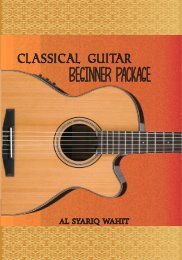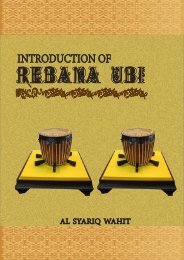You also want an ePaper? Increase the reach of your titles
YUMPU automatically turns print PDFs into web optimized ePapers that Google loves.
Steel strings first became widely available in around 1900. Steel strings<br />
offered the promise of much louder guitars, but the increased tension was<br />
too much for the Torres-style fan-braced top. A beefed-up X-brace proved<br />
equal to the job, and quickly became the industry standard for the flat-top<br />
steel string guitar.<br />
At the end of the 19th century Orville Gibson was building archtop guitars<br />
with oval sound holes. He married the steel-string guitar with a body constructed<br />
more like a cello, where the bridge exerts no torque on the top, only<br />
pressure straight down. This allows the top to vibrate more freely, and thus<br />
produce more volume. In the early 1920's designer Lloyd Loar joined<br />
Gibson, and refined the archtop "jazz" guitar into its now familiar form with<br />
f-holes, floating bridge and cello-type tailpiece.<br />
The electric guitar was born when pickups were added to Hawaiian and<br />
"jazz" guitars in the late 1920's, but met with little success before 1936,<br />
when Gibson introduced the ES150 model, which Charlie Christian made<br />
famous. With the advent of amplification it became possible to do away<br />
with the soundbox altogether. In the late 1930's and early 1940's several<br />
actors were experimenting along these lines, and controversy still exists as<br />
to whether Les Paul, Leo Fender, Paul Bigsby or O.W. Appleton constructed<br />
the very first solid-body guitar. Be that as it may, the solid-body electric<br />
guitar was here to stay.










